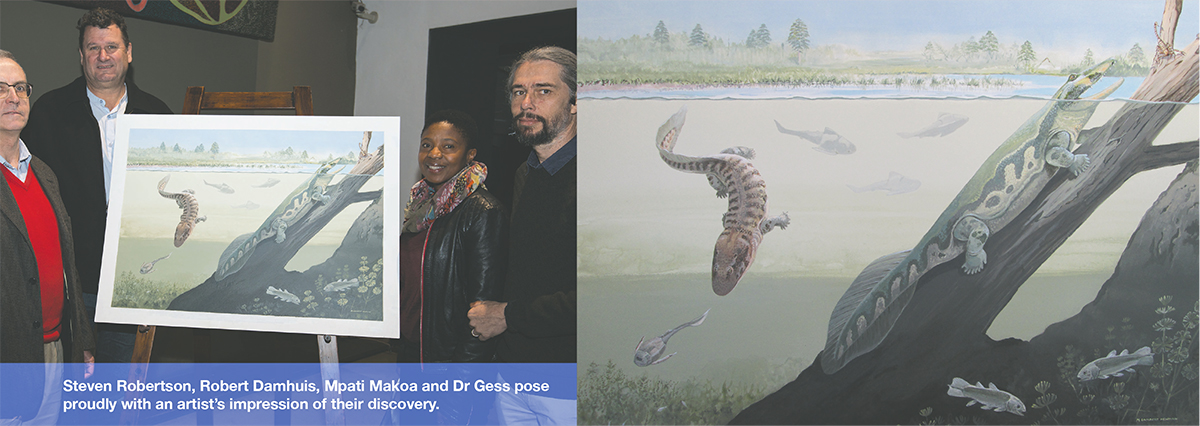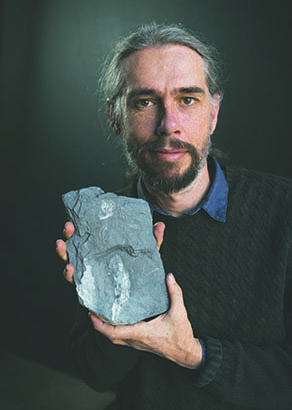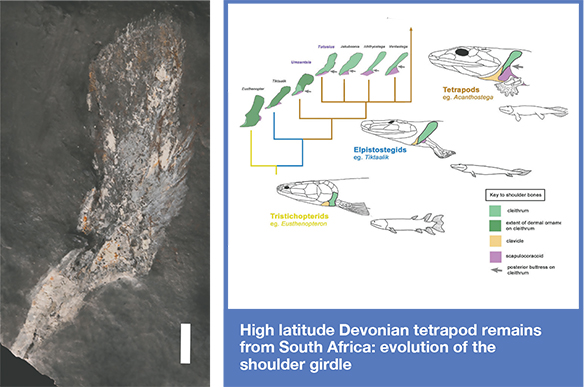
Though obviously delighted, Gess was not surprised to find various late Devonian plant fossils at the site, but it has become increasingly clear that this is the most important discovery of a Late Devonian estuary from anywhere in the southern hemisphere. A whole range of plants and about 20 types of fish – all totally new to science – have been discovered there.
In 2008, a further 70 tons of shale were rescued, and to assist further, SANRAL built a shed next to Dr Gess’s existing one to store the shale blocks and protect the fossils from weather damage.
The Waterloo Farm dig has given the world a detailed picture of what life was like on the extreme southern coast of ancient supercontinent Gondwana (more on this later). It has provided an astonishing array of discoveries, though most of these fit fairly comfortably into the accepted picture of the Devonian world – until Dr Gess found something all the textbooks assured him shouldn’t be there – Devonian tetrapods.
At one point in the evolution of life on Earth, sea creatures moved onto the land – which is pretty difficult if the only moving equipment you have is fins. Some fishes grew legs. These ‘fourlegged fish’ are known as tetrapods. Everything that walks on land is descended from them – including us. Dr Gess explains: “During the Devonian Period (360 to 420 million years ago), the ancestors of all landliving vertebrates evolved from lobefinned fish.
These creatures had traded their fins for four stubby legs, but retained a tadpole-like tail. About a metre long, they looked superficially like a cross between fish and alligators and

lived in pools, lakes and lagoons, where they probably inhabited the shallows. Shortly after the End Devonian Mass Extinction Event, their descendants moved onto land and gave rise to land vertebrates – amphibians, reptiles, birds and mammals.”
Back in the Devonian period, Earth’s land masses looked rather different. Laurussia was a northern supercontinent that later fragmented into North America, Greenland and Europe, where most Devonian tetrapod fossils have been found. On closer examination, all of these deposits came from the paleotropics – between 30 degrees north and south of the equator. Gondwana was the southern
Circle – pretty far from tropical. So until now, it has been safe to assume that the first vertebrates with legs made their migration from water to land only in the tropics. That’s what the textbooks say. But this year, Gess turned the established theory on its head, with the publication of his discovery of our first legged ancestors from the Waterloo Farm site in the Eastern Cape. What he found were tetrapod shoulder, skull and jaw bones.
Everything he had learnt told him that Devonian tetrapods didn’t belong there. They had never been found as far south as the Devonian Antarctic circle. It was like finding human bones on the Moon.
Everything Dr Gess had learnt told him that
Devonian tetrapods didn’t belong there. They had
never been found as far south as the
Devonian Antarctic circle. It was like finding
human bones on the Moon.
supercontinent that eventually split into Africa, South America, Australia, Antarctica and India, where almost no Tetrapod fossils have been found. Back then, bits of Australia formed the northernmost tip of Gondwana, extending into the tropics, and a single Devonian tetrapod jaw was found there. But the rest of Gondwana stretched down into the Antarctic Circle, where it would’ve had months of darkness and cold during the winter. What is now South Africa used to be in the Antarctic
In June, Gess and Uppsala University colleague Prof Per Ahlberg published their findings in Science, in a paper titled ‘Tetrapods from the Devonian Antarctic Circle’, highlighting the global significance of late Devonian research in the Eastern Cape. “Whereas all previously found Devonian tetrapods have come from localities which were in tropical regions during the Devonian Period, the Grahamstown specimens represent species that lived in the Antarctic Circle and thus force a

major reassessment of the origin of fourlegged vertebrates,” Gess said.
But the intrepid explorer of our ancient past always held out some hope for Waterloo Farm. “I had read Dr Jenny Clack’s book, Gaining Ground, and had familiarised myself with the skeletal transformations involved in the fish-totetrapod transition. I was splitting shale with my student, Chris Harris, when I found the cleithrum [shoulder bone] of Tutusius [the name given to one of the tetrapods]. I just knew that this was what I’d spent years looking for. I went all quiet, then abandoned what I was doing and went to fetch the literature just to double-check. I’ll never forget that afternoon,” he said.
“The fact that the tetrapods were found at the Waterloo Farm site gives us a really good picture of the environmental setting in which they lived. Of all sites in the world that have tetrapod remains, Waterloo Farm has the best record of what plants and animals were in the ecosystem that the tetrapods were living in. “This is the only site in the world that has tetrapod remains but also softtissue preservation. The rock shed that SANRAL donated has almost certainly preserved more remains of the bony parts of the Devonian tetrapods, but it is possible that further excavations might reveal evidence of the non-bony parts – which are as yet unknown from anywhere.” SANRAL’s standard management plans contain guidelines for project managers who may encounter similar cases of paleontological heritage, especially in areas where experts believe the potential for fossil finds is high.
SANRAL’s Southern Region Manager Mbulelo Peterson is as proud as Dr Gess is of this discovery and emphasises that the agency’s partnerships with academia are extremely important. “In 2016, as part of a conservation plan for the N2 Wild Coast Road (N2WCR), we initiated our environmental management programme, which is aimed at protecting the biological diversity of the Eastern Cape. As part of this programme, we have already conducted paleontological training for environmental and other personnel to sensitise them to the potential for and signs of paleontological finds,” he said.
 Building South Africa through better roads
Building South Africa through better roads